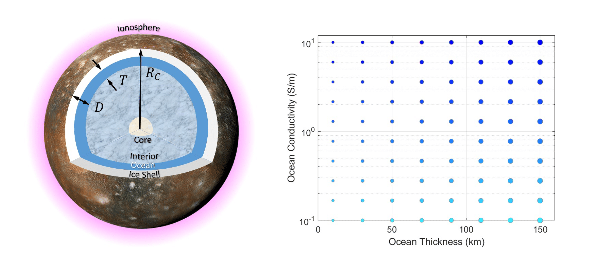The Galileo probe has confirmed the existence of an ocean within Callisto.
Visually, Jupiter's moon Callisto draws attention with its brown, rocky surface dotted with bright white spots. These are craters, evidence of asteroid impacts. They appear white because a thin upper layer of soil conceals a global crust of pure water ice. In this regard, Callisto is only differentiated from its ice-covered neighbor Europa by its "dustiness."
It is the second largest moon of Jupiter after Ganymede and one of the largest in the entire Solar System, measuring over 4,800 kilometers in diameter. Its size is almost comparable to Mercury. However, Mercury is about three times more massive than Callisto, which clearly indicates that this Jovian moon is not merely rocky, but rather a rock-ice composite.
Between 1995 and 2003, the Galileo probe operated in the Jupiter system, making a total of eight flybys of Callisto. Among its instruments was a magnetometer. Callisto does not generate its own magnetic field because a substantial amount of molten metal in its core is required for that, and, as mentioned earlier, there are no hints of such a composition in Callisto. However, Jupiter itself has an extremely powerful magnetic field that creates a magnetosphere extending for millions of kilometers.
Of the four Galilean moons of the gas giant, Callisto is the farthest away, at nearly 1.9 million kilometers. Nevertheless, this moon is still within the planet's magnetic shield. The magnetosphere constantly captures charged particles streaming from the Sun, and these particles "rain down" on the moons. The Galileo magnetometer indicated that induced currents arise on Callisto due to this effect. This suggests that the celestial body contains material with good electrical conductivity.
There are two theories regarding what this material could be. The first is its own plasma that hovers above Callisto. The moon has a very thin atmosphere, which creates a relatively rich ionosphere in its upper layers. Interestingly, data from Galileo suggest that this atmosphere is primarily composed of molecular oxygen rather than carbon dioxide, as previously thought. The second possibility for the source of the induced currents is water, specifically saline water, as salt water conducts electricity even better.
Both theories were recently examined by an international team of researchers, who presented their findings in an article for the publication AGU Advances. The scientists compared the data from the Galileo magnetometer and concluded that Callisto's ionosphere alone is insufficient to cause the observed magnetic disturbances; a much denser material is required. Therefore, there are grounds to suspect a significant layer of electrically conductive material beneath the icy crust of the moon, and it is hard to imagine anything other than a subsurface salty ocean as such a layer.

Using computer modeling, physicists calculated thousands of variations in the thickness and depth of this proposed layer of water within Callisto. Ultimately, they lean towards the idea that a subsurface ocean could begin at a depth of at least several tens or even approximately 150 kilometers. The estimated thickness of the water layer is expected to exceed 50 kilometers, with specific scenarios considering thicknesses of 70 and 110 kilometers. Thus, the bottom of the proposed ocean could lie between 150 and 300 kilometers beneath the surface of the celestial body.
It is worth noting that subsurface oceans are also suspected to exist on Europa, Saturn's moon Enceladus, and even Uranus's moon Miranda. The likely source of heat for maintaining water in a liquid state is known as tidal heating: the planet's gravity slightly deforms the moon as it moves along its orbit, creating friction within it. Interestingly, calculations suggest that Callisto is subjected to this effect much less than the other three largest moons.